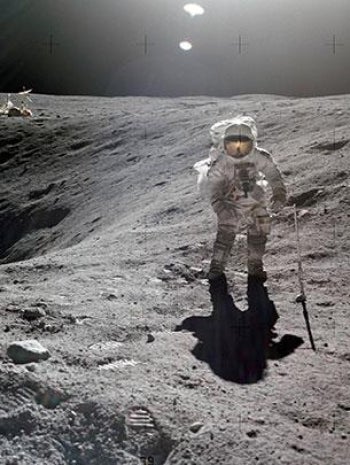Apollo lunar samples enable ASU researcher to pinpoint moon’s crystallization timeline

An artist’s illustration of what the partly molten moon might have looked like. Illustration courtesy of NASA Goddard Space Flight Center
A team of researchers, including Arizona State University geochemist Melanie Barboni, in collaboration with scientists from The University of Chicago, have made a new discovery about the history of the moon using lunar rocks from Apollo missions. Their findings suggest the moon solidified approximately 4.43 billion years ago, shedding new light on both lunar and Earth history.
A lingering mystery
The moon has captivated humans for millennia, yet much about its origins remains uncertain. Scientists theorize that a massive collision between Earth and another celestial body led to the formation of the moon. However, determining the exact timeline of this event has been a challenge.
Now, using cutting-edge techniques to analyze rare minerals in Apollo moon rock samples, researchers have obtained a precise age for when the moon crystallized. The new findings not only refine our understanding of lunar history but also offer insights into the time when Earth became habitable.
The results of their study have been recently published in Proceedings of the National Academy of Sciences.
“Determining when the moon’s magma ocean crystallized has been an open question for decades,” said Barboni, an assistant professor with ASU’s School of Earth and Space Exploration. “This study refines that timeline, showing that the final stages of lunar solidification happened earlier than some previous estimates suggested. Understanding this process helps us link the moon’s evolution to early-Earth history.”
Pinpointing the moon’s age
The solar system formed about 4.57 billion years ago, and shortly thereafter, planets and moons took shape. Scientists believe a cataclysmic impact between Earth and another body created a molten mass that eventually became the moon. Initially, this young moon was a massive sphere of magma floating in space. Most of this magma cooled relatively quickly on a geological scale — within about 1,000 years — but a final phase of crystallization remained elusive.
To determine when the moon fully solidified, researchers focused on a distinct mineral layer rich in potassium, rare earth elements and phosphorus (known as KREEP). These elements accumulated as the moon’s magma ocean cooled, and scientists theorized that dating this layer would provide a reliable estimate for the moon’s final crystallization.
Lunar rock clues
A key part of this study was analyzing the radioactive decay of lutetium, an element found in KREEP. Over billions of years, lutetium gradually transforms into hafnium at a known rate. By measuring the ratio of these elements in moon rocks and comparing them with meteorites from the same era, the researchers determined when the KREEP layer formed — placing the moon’s crystallization at 4.43 billion years ago.
These findings suggest the moon itself likely formed around 4.45 billion years ago, since studies indicate it would have taken about 20 million years to cool to that level. This time frame also marks a critical period in Earth’s history, as the moon-forming impact was likely the last major event shaping our planet before it stabilized and became hospitable to life.
“This work shows why returning to the moon is so important,” Barboni emphasized. “Apollo gave us an incredible foundation, but there are still so many questions left unanswered. With Artemis and future sample return missions, we’ll be able to test ideas that were unthinkable in the Apollo era.”
Arizona’s role in lunar exploration
Arizona has long played a crucial role in lunar and planetary research. Institutions such as Arizona State University and the University of Arizona have contributed significantly to moon and Mars exploration. The state's unique desert landscapes have even served as training grounds for Apollo astronauts.
“Arizona has a strong legacy in planetary science, and that tradition continues today,” Barboni said. “From laboratory studies to mission planning, we are deeply involved in shaping the future of lunar exploration.”
“These findings provide a clearer picture of how and when the moon formed, which in turn helps us understand Earth’s own history,” said first author Nicolas Dauphas, who heads the UChicago Origins Laboratory and is a professor in the Department of the Geophysical Sciences and the Enrico Fermi Institute. “With upcoming lunar missions like Artemis, we are on the brink of even more exciting discoveries.”
As new missions prepare to return humans to the moon, Arizona’s scientific community remains at the forefront of research, helping to unlock the mysteries of our celestial neighbor.
More Science and technology

ASU technical innovation enables more reliable and less expensive electricity
Growing demand for electricity is pushing the energy sector to innovate faster and deploy more resources to keep the lights on and costs low. Clean energy is being pursued with greater fervor,…

What do a spacecraft, a skeleton and an asteroid have in common? This ASU professor
NASA’s Lucy spacecraft will probe an asteroid as it flys by it on Sunday — one with a connection to the mission name.The asteroid is named Donaldjohanson, after Donald Johanson, who founded Arizona…

Hack like you 'meme' it
What do pepperoni pizza, cat memes and an online dojo have in common?It turns out, these are all essential elements of a great cybersecurity hacking competition.And experts at Arizona State…


